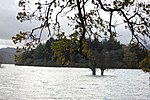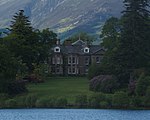Ashness Bridge
Cumberland (unitary authority)Cumbria building and structure stubsGrade II listed bridges in CumbriaLake DistrictPackhorse bridges ... and 3 more
Stone bridges in EnglandUnited Kingdom bridge (structure) stubsUse British English from January 2018

Ashness Bridge is a traditional stone-built bridge on the single-track road from the Borrowdale road (B5289) to Watendlath, in the English Lake District, Cumbria. The bridge is at grid reference NY270196, and is known for being a fine viewpoint across Borrowdale towards Skiddaw, including views of Derwent Water nearby. It or its predecessor may have been a packhorse bridge conveying packhorse traffic from Watendlath to Keswick. Near the bridge is a small cairn to Bob Graham, who ran a round of 42 Lakeland peaks in 1932 in under 24 hours, a record which was not equalled for 28 years. The area is owned by the National Trust.
Excerpt from the Wikipedia article Ashness Bridge (License: CC BY-SA 3.0, Authors, Images).Ashness Bridge
Ashness Bridge,
Geographical coordinates (GPS) Address External links Nearby Places Show on map
Geographical coordinates (GPS)
| Latitude | Longitude |
|---|---|
| N 54.5672045 ° | E -3.1301167 ° |
Address
Ashness Bridge
Ashness Bridge
CA12 5UR
England, United Kingdom
Open on Google Maps








